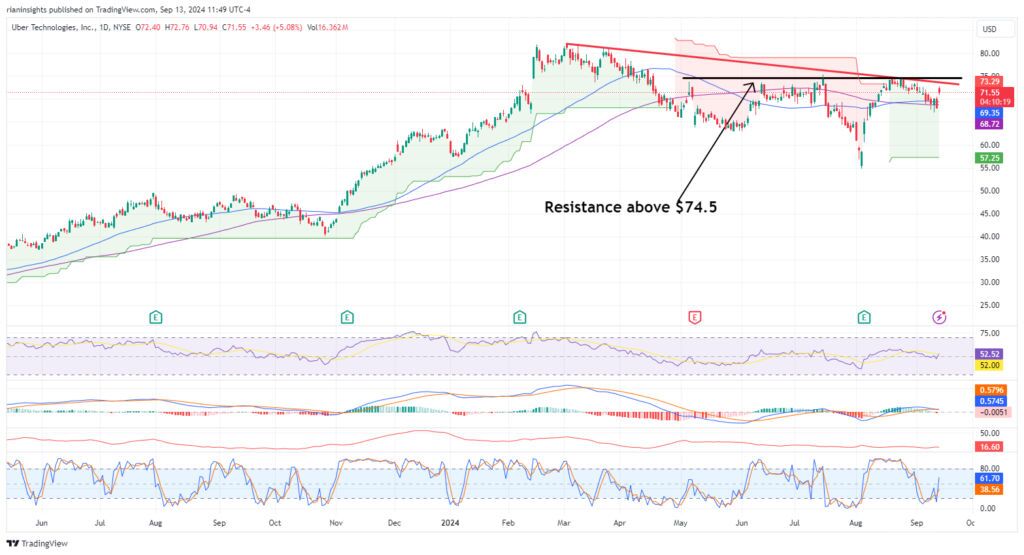Is Uber A Buy Following Robotaxi Deal With Waymo?
Uber Technologies Inc. (UBER) saw its stock jump over 5% on Friday after announcing an expanded partnership with Waymo, the autonomous driving subsidiary of Alphabet Inc.
The collaboration will bring fully autonomous ride-hailing services to Austin and Atlanta by early 2025, marking a significant milestone in Uber’s strategy to integrate autonomous vehicles (AVs) into its platform.
Waymo’s all-electric Jaguar I-PACE vehicles will be available for UberX, Uber Green, Uber Comfort, and Uber Comfort Electric rides in these cities, with plans to scale the fleet into the hundreds over time.
This expansion builds on Uber’s previous deals, including a multiyear partnership with General Motors’ Cruise, which will bring Chevy Bolt-based autonomous vehicles to Uber’s platform next year.
The announcement of this expanded partnership comes on the heels of Uber’s strategic investment in AI tech firm Wayve, which is focused on developing Level 4 autonomous vehicles.
This move signals Uber’s commitment to advancing its AV capabilities and maintaining its competitive edge as the technology matures.
Additionally, Uber’s recent $4 billion bond offering, following its upgrade to investment-grade status by major credit rating agencies, underscores its solid financial position.
The proceeds from this offering will be used to pay down existing debt, further strengthening Uber’s balance sheet.
Uber Q2 2024 performance
Uber’s Q2 2024 earnings report further highlighted the company’s strong financial performance.
The company posted revenue of $10.7 billion, up 15.9% year-over-year, beating analyst expectations by $120 million.
Gross bookings grew by 19% YoY to $40 billion, driven by a 23% increase in Mobility bookings and a 16% rise in Delivery bookings.
The company achieved an adjusted EBITDA of $1.6 billion, a 71% YoY increase, demonstrating significant operational efficiency.
Uber also generated $1.7 billion in free cash flow, ending the quarter with $6.3 billion in unrestricted cash and short-term investments.
Uber’s capital-light approach
Despite the positive earnings, Uber continues to navigate a dynamic and competitive landscape.
The company is making significant strides in the AV space, evidenced by its partnerships with Waymo, Cruise, and BYD.
Uber’s CEO Dara Khosrowshahi has emphasized the company’s focus on leveraging these partnerships to enhance its platform while maintaining a capital-light approach.
Khosrowshahi also highlighted growth opportunities in advertising, particularly in sponsor listings and grocery delivery, which have seen substantial gains in recent quarters.
Uber’s ongoing expansion into international markets, including its recent growth in South Korea despite stiff competition from local players, further underscores its global ambitions.
The company has managed to capture nearly 20% of the South Korean taxi market, with a significant year-over-year increase in passenger numbers.
This growth is supported by Uber’s broader strategy of becoming a transportation super app, offering a range of services at different price points to increase user loyalty and spending.
Uber stock valuation
On the valuation front, Uber currently trades at a forward EV/EBITDA multiple of 22.8x, reflecting a market that recognizes its growth potential but remains cautious of the challenges ahead.
The stock’s recent rally, fueled by strong Q2 results and strategic partnerships, suggests that there is still room for upside, particularly as Uber continues to innovate in the AV space and expand its advertising business, which now contributes over $1 billion annually.
As investors digest these developments, it’s essential to consider how they are reflected in the stock’s current price action.
With significant catalysts on the horizon, we now turn to the charts to analyze the technical patterns and indicators that could guide Uber’s stock movement in the coming weeks.
Uber stock technical analysis
Uber’s stock saw a rapid surge from $30 levels to above $80 between April last year and March this year.
However, the stock has lost some steam since then.
(Click on image to enlarge)

Source: TradingView
It has been making lower highs and lower lows since March indicating a medium-term downtrend.
Moreover, the stock has faced significant resistance trading above $74.5 since May.
Hence, investors who are bullish on the stock must wait for it to give a weekly closing above $74.5 before initiating a fresh long position.
Traders who have a bearish outlook on the stock can initiate a short position at current levels near $71.5 with a stop loss of $75.1.
If the bearish momentum intensifies it can again take the stock below $60, where one can book profits.
More By This Author:
European Central Bank Slashes Interest Rates Again, Cuts Growth Forecasts
US Bitcoin ETFs Face $1.2 Billion In Losses Amid Longest Streak Of Net Outflows
4 Reasons Why Pi Network Mainnet Launch May Not Happen Soon
Disclosure: Invezz is a place where people can find reliable, unbiased information about finance, trading, and investing – but we do not offer financial advice and users should always ...
more


